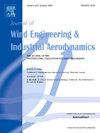Long-span bridge flutter analysis in non-stationary downburst-like flows by Floquet Theory
IF 4.9
2区 工程技术
Q1 ENGINEERING, CIVIL
Journal of Wind Engineering and Industrial Aerodynamics
Pub Date : 2025-06-18
DOI:10.1016/j.jweia.2025.106138
引用次数: 0
Abstract
This study examines the research question whether bridge flutter instability can be triggered by thunderstorm downburst-like flows. The Floquet Theory is used to formulate a new analytically-based model, in which the loads are simulated using a transient periodic mean wind speed. This feature imitates the touchdowns of subsequent downbursts in the proximity of the deck at a relative distance corresponding to the maximum spatial intensification (equal to about with downburst horizontal core or “jet” diameter). The model accounts for the slow variations in the mean-wind flow velocity to evaluate flutter. Although this assumption may lead to a conservative estimation of the instability threshold, the study demonstrates that the critical flutter velocity is finite. Specifically, the model quantifies in closed form the minimum downburst intensity, i.e., the magnitude of the mean, horizontal along-wind velocity component, which causes the deck vibration to diverge. Two bridge models are used to illustrate the method: the Golden Gate Bridge and the Messina Strait Bridge (1992 design).
基于Floquet理论的非平稳类下爆流大跨度桥梁颤振分析
本研究探讨了雷暴式下突流是否会引发桥梁颤振失稳的研究问题。利用Floquet理论建立了一种新的基于解析的模型,该模型采用瞬态周期平均风速来模拟荷载。这一特征模拟了在甲板附近以最大空间强度对应的相对距离r(约等于r/Ddb=1.0, Ddb下爆水平核心或“射流”直径)的后续下爆的触地。该模型考虑了平均风速的缓慢变化来评估颤振。虽然这种假设可能导致失稳阈值的保守估计,但研究表明临界颤振速度是有限的。具体而言,该模型以封闭形式量化了最小下击强度,即导致甲板振动发散的平均水平沿风速分量的大小。两个桥梁模型被用来说明这种方法:金门大桥和墨西拿海峡大桥(1992年设计)。
本文章由计算机程序翻译,如有差异,请以英文原文为准。
求助全文
约1分钟内获得全文
求助全文
来源期刊
CiteScore
8.90
自引率
22.90%
发文量
306
审稿时长
4.4 months
期刊介绍:
The objective of the journal is to provide a means for the publication and interchange of information, on an international basis, on all those aspects of wind engineering that are included in the activities of the International Association for Wind Engineering http://www.iawe.org/. These are: social and economic impact of wind effects; wind characteristics and structure, local wind environments, wind loads and structural response, diffusion, pollutant dispersion and matter transport, wind effects on building heat loss and ventilation, wind effects on transport systems, aerodynamic aspects of wind energy generation, and codification of wind effects.
Papers on these subjects describing full-scale measurements, wind-tunnel simulation studies, computational or theoretical methods are published, as well as papers dealing with the development of techniques and apparatus for wind engineering experiments.

 求助内容:
求助内容: 应助结果提醒方式:
应助结果提醒方式:


